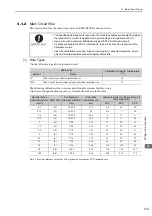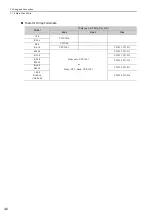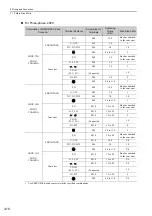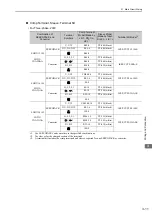
2.3 Parameters (Pn
)
2-5
2
Pan
el Op
erator
2.3
Parameters (Pn
)
This section describes the classifications, methods of notation, and settings for parameters given in this man-
ual.
2.3.1
Parameter Classification
Two types of parameters are used in
Σ
-V large-capacity SERVOPACKs. One type of parameters is required
for setting up the basic conditions for operation and the other type is required for tuning parameters that are
required to adjust servomotor characteristics.
There are two types of notation used for parameters, one for parameter that requires a value setting (parameter
for numeric settings) and one for parameter that requires the selection of a function (parameter for selecting
functions).
The notation and settings for both types of parameters are described next.
2.3.2
Notation for Parameters
(1) Parameters for Numeric Settings
Classification
Meaning
Display Method
Setting Method
Setup Parameters
Parameters required for
setup.
Always displayed (Factory
setting: Pn00B.0 = 0)
Set each parameter individu-
ally.
Tuning Parameters
Parameters for tuning con-
trol gain and other parame-
ters.
Set Pn00B.0 to 1.
There is no need to set each
parameter individually.
Pn406
Emergency Stop Torque
Setting Range
0 to 800
1%
800
After change
Setting Unit
Factory Setting
When Enabled
Classification
Setup
Parameter
number
Position
Torque
The control methods for which the parameters applies.
Speed : Speed control
: Position control
: Torque control
Indicates the
parameter setting
before shipment.
Indicates when a
change to the
parameter will be
effective.
Indicates the
parameter
classification.
Indicates the
minimum setting unit
for the parameter.
Torque
Position
Speed
Indicates the setting
range for the parameter.
Parameter
Meaning
When Enabled
Classification
Pn002
After restart
n.
0
[Factory setting]
n.
1
Uses the absolute encoder as an
incremental encoder.
Uses the absolute encoder as an
absolute encoder.
Setup
Parameter
number
The notation “n.
” indicates a parameter
for selecting functions. Each
corresponds to
the setting value of that digit. The notation
shown here means that the third digit is 1.
This section explains the
selections for the function.
(2) Parameters for Selecting Functions
Rotation
















































